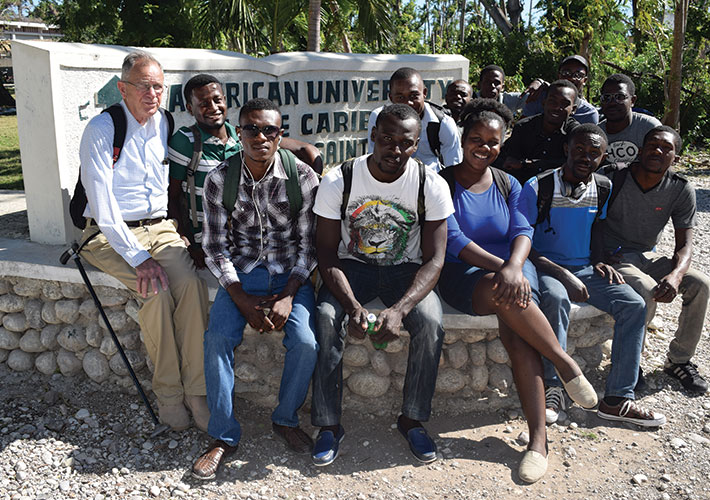
Rebuilding, Not Retiring
(Photo above: Herb Nordmeyer (left) with some of his students at the American University of the Caribbean in Haiti.)
Longtime ASTM International member Herb Nordmeyer never planned to go to Haiti.
By the time he reached 70, Nordmeyer had already had an eventful career. He had worked as a consultant on the use of pozzolans in masonry cements and stuccos. Later, he set up a cement research laboratory for a company called Best Masonry and Tool Supply.
While in the latter role, he joined ASTM International to give his company a presence on the committees for cement (C01), gypsum and related building materials and systems (C11), and mortars and grouts for unit masonry (C12). In addition, Nordmeyer eventually joined the committees on manufactured masonry units (C15) and precast concrete products (C27).
Once he retired, Herb planned to lead wilderness kayaking trips, create books with his granddaughters, and write devotions for his church. But one short-term mission for that church to Haiti in September 2013 has led to many more visits and a commitment that could keep Nordmeyer busy for years to come.
During his initial trip, Nordmeyer was shown the critical need for earthquake- and hurricane-resistant housing by Pastor Revenel Benoit, president of the Lutheran Church of Haiti. Benoit challenged Nordmeyer to develop technology that could be used to build low-cost, disaster-resistant structures.
His early work was done directly with people in need of safely constructed homes. He looked for ways to get the best results from available materials.
He also worked with David South of the Monolithic Dome Institute, to develop an inexpensive, modified “EcoShell” dome for an area known as Jubilee in Haiti. The 6-m (20-foot) and 9-m (30-foot) diameter domes are built by local crews using balloon-like forms and basalt rope rebar, with a final thickness of about 60 mm (2.5 inches).
To document this work, Nordmeyer wrote a book, Homes for Jubilee (Kay pou Jubilee in Haitian Creole), that tells the story of how the technology was developed. The book also serves as a construction manual. “In much of Haiti, building materials, except for imported Portland cement, that come close to meeting ASTM International standards do not exist,” says Nordmeyer. “Without a major influx of capital and training, that is not going to change during the next decade.”
Indeed, he is now focused on capacity building. He teaches one course a year, based on his experiences in Haiti, to engineering students at Haiti’s American University of the Caribbean in Les Cayes.
In February of this year, Nordmeyer was honored for his work with the Four Chaplains Award, named for U.S. military chaplains of different faiths who died – giving their life jackets to others on a sinking ship – following a torpedo attack in World War II.
Chris Peche, a former recipient of the Four Chaplains Award, nominated Nordmeyer after hearing about his work in Haiti.
“He worked with local people to train them to help their fellow citizens, helping them without prejudice or discrimination,” Peche said. “That’s exactly what the Four Chaplains did – gave their lives without question to save and therefore give men a chance at a fuller life.”
Despite Nordmeyer’s “retired” status, his work in Haiti continues to energize him. “There is much to do in Haiti, and for that matter, around the world,” Nordmeyer says. “If anyone would like to discuss the needs, I am always ready to talk.”
 SN Home
SN Home Archive
Archive Advertisers
Advertisers Masthead
Masthead RateCard
RateCard Subscribe
Subscribe Email Editor
Email Editor